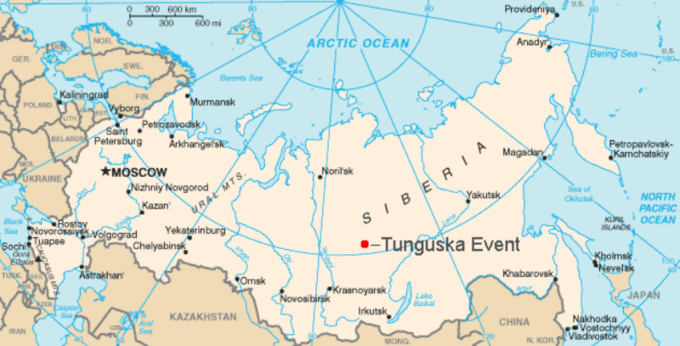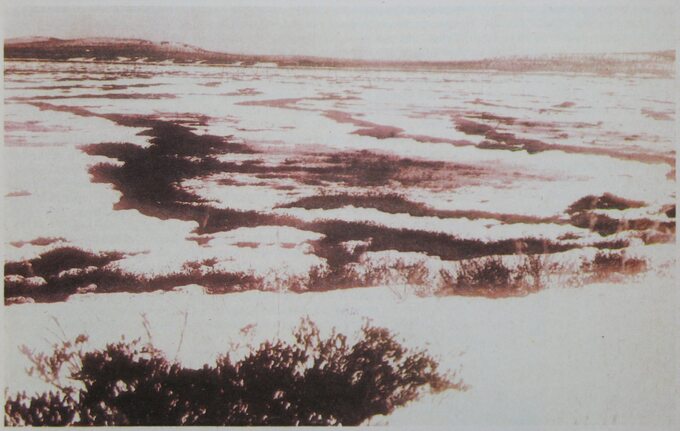The Tunguska disaster occurred on June 30, 1908 in the Taiga, Siberia, north of Lake Baikal, on the Podkamiena Tunguska River. To this day, it is not fully known what caused it. Trees were cut down within a radius of 40 kilometers, and magnetometers showed that the North Pole was located… in central Russia. How is this possible?
Explosion and falling trees
On June 30, 1908, a powerful explosion occurred, which was heard within a radius of 1000 kilometers. At the site of the disaster, the trees were burnt, and all the trees that grew in a radius of 40 kilometers were cut down. An earthquake from central Siberia was recorded by seismographs all over the world. Magnetometers in Russia have even begun to indicate that the North Pole is located in the uninhabited regions of Siberia near Lake Baikal.
The only indirect witnesses to the event were the Evenks, a people who lived in south-central Siberia. At the time, they lived about 100 kilometers from the site of the disaster, but its consequences still affected them. During the explosion, people suffered burns, and some lost their sight for several days. A minute after the loud boom was heard, the shock wave reached the Evenki village, knocking down people and destroying houses.

Over the past 100 years, many hypotheses have emerged about the Tunguska disaster. However, it is still unknown what actually happened. The most frequently repeated theory is that a celestial body (asteroid?) or several celestial bodies collided with the Earth or exploded within a few kilometers of the Earth's surface. That there could have been more than one object is evidenced by the presence of three huge holes in the ground in the disaster area.
The first scientific expedition worked at the site of the Tunguska disaster only in 1927, 19 years after the explosion. The study was conducted by Leonid Kulik of the Russian Academy of Sciences, who wanted to prove that the cause of the event was a meteorite impact. At the site, his research team discovered strange, deformed trees that had grown since the 1908 disaster. Many small glass balls resembling tektite have also been found. Kulik did not prove his thesis about the meteorite, but thanks to the materials obtained by his team, other researchers were also interested in the mysterious event.
theories
Czechoslovakian astronomer Jubor Kresak then suggested that a meteoroid, a fragment of Comet Enke, was responsible for the disaster. Other researchers believed that an asteroid or meteoroid fell near Podkamena Tunguska, but did not reach Earth and exploded some distance above it. The last thesis was supported by the absence of a crater.

Extensive research was conducted only in 1973-1979. After conducting laboratory tests of peat from the disaster site, scientists put forward the thesis that a meteoroid, small asteroid or comet was responsible for the Tunguska disaster. More than seven cosmic substances were found in peat.
Further theories, among others, say: about the collision of the Earth with a meteorite the size of a skyscraper. As a result of this collision, a mushroom of glowing water vapor was formed, which “prepared” the area around the crash site. Molten ash and sand should have turned into tektites – glass balls.
Two theses are most likely. The Tunguska disaster may have been caused by the explosion of a stony asteroid (a diamond-bearing meteorite) that exploded about 5-10 kilometers above the Earth. The energy generated by the explosion ignited trees for miles around, but the shock wave that followed instantly extinguished the flames. The explosion on the Podkamiena Tunguska River could have been a thousand times more powerful than the atomic bomb dropped on Hiroshima.
Another theory is that the comet exploded over central Siberia, which quickly heated up as it entered the atmosphere and vaporized during the explosion, preventing it from reaching the Earth's surface. However, the force of the explosion could have been so great that millions of trees fell. Will scientists present further theories about the Tunguska disaster? Perhaps because it continues to intrigue a new generation of researchers.
Also read:
Messina. The worst earthquake in the history of EuropeAlso read:
The Wright Brothers and the Revolution in the Sky. What was the first airplane flight like?Also read:
Ten mysterious places that have fascinated people for centuries
(translate tags)Tunguska disaster
